Product Description
6774 A two-fold paper screen painted in ink and colour on a gold ground with a tsuru (crane) in flight over cresting waves and with matsu (pine trees) in the distance
Japan late 18th / early 19th Edo period
Dimensions: H. 65¾” x W. 70½” (166.5cm x 179cm)
Tsuru (cranes) are among the premier symbols of longevity and good fortune in East Asia. For at least two millennia, the Chinese have viewed them as living to a great age and as being able to navigate between heaven and earth. In turn, these attributes have made them logical companions of sennin, the Taoist Immortals. Ancient Taoist alchemists believed that imbibing beverages made with crane eggs or tortoise shells would increase one’s vital energies. The red-crowned, or Japanese, crane depicted in this screen is said to live for 1,000 years.
In Japan, the crane is the animal most frequently seen in the fine and applied arts. Although a common subject of painting, it is most closely associated with the New Year and with marriage ceremonies. In earlier times, when the Japanese still used circular brass mirrors and presented them on the occasion of a marriage, the crane was a favoured decorative theme due to its association with fidelity. In recent centuries, the crane has appeared on elaborately embroidered wedding kimono and among the mizuhiki (cord made from twisted paper) decorations presented at the time of betrothal.






